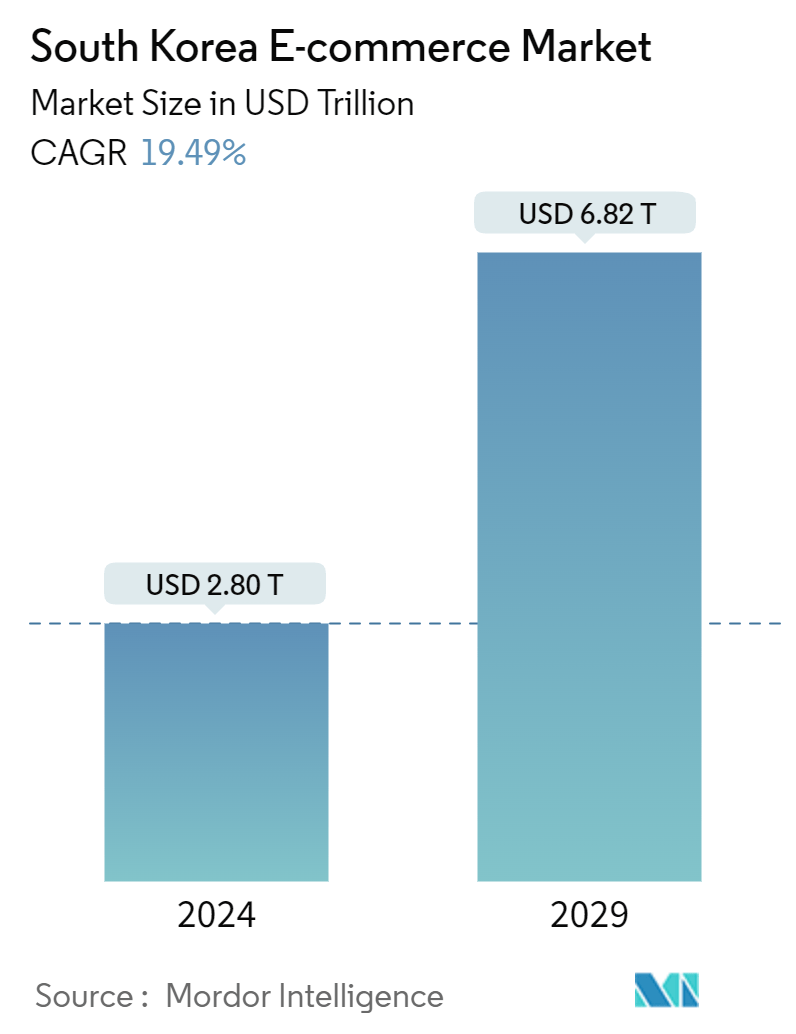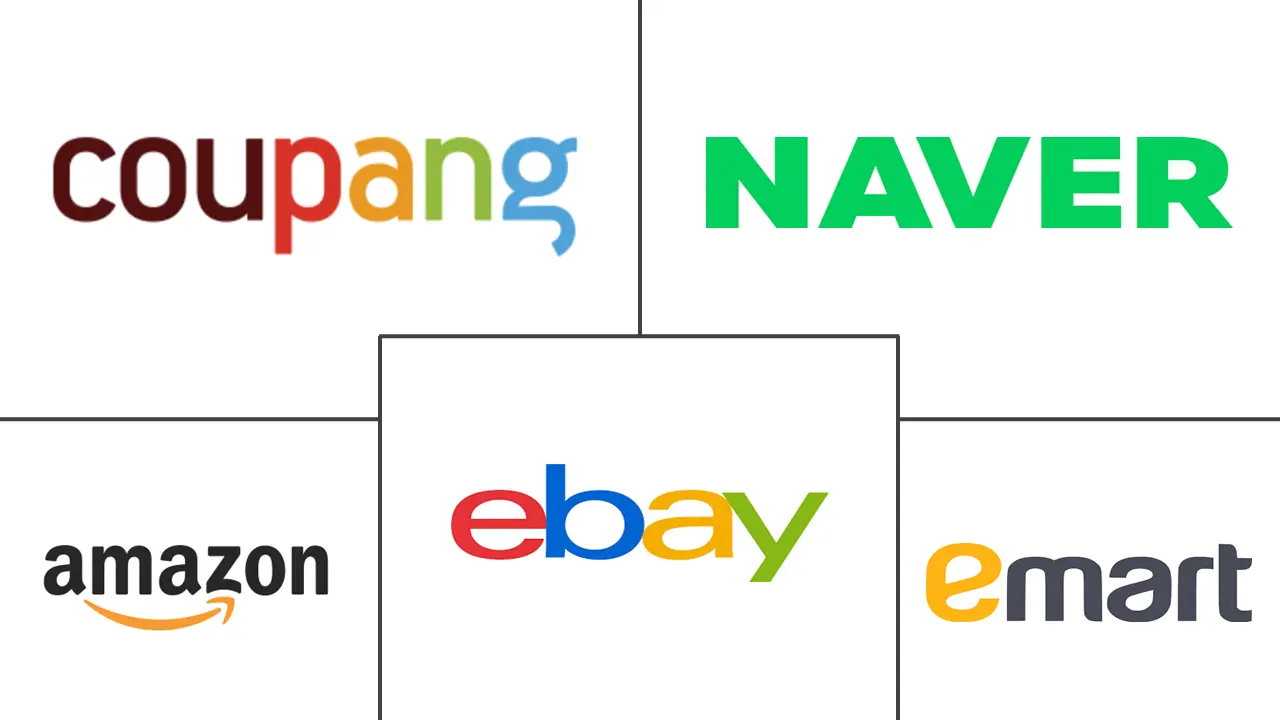Market Size of South Korea E-commerce Industry

| Study Period | 2019 - 2029 |
| Base Year For Estimation | 2023 |
| Market Size (2024) | USD 2.80 Trillion |
| Market Size (2029) | USD 6.82 Trillion |
| CAGR (2024 - 2029) | 19.49 % |
| Market Concentration | Low |
Major Players
*Disclaimer: Major Players sorted in no particular order |
South Korea E-commerce Market Analysis
The South Korea E-commerce Market size is estimated at USD 2.80 trillion in 2024, and is expected to reach USD 6.82 trillion by 2029, growing at a CAGR of 19.49% during the forecast period (2024-2029).
- The country's retail sector is being rewired by digitally inspired innovations that go beyond the channel shift. Owing to the COVID-19 pandemic, new business models gained traction, and commerce ecosystems evolved, altering how retailers and brands interacted with digitally connected audiences. The digital revolution resulted in a more convoluted and fragmented retail market during the previous decade. Marketplaces, direct-to-consumer brands, social commerce, live selling, and voice commerce are examples of the various paths to the end consumer, showing the growth adoption of e-commerce channel sales in the country.
- The International Trade Administration reported that e-commerce is a significant part of the country's entire consumer industry and is continually rising. Korea is a technologically advanced country, with about 99.96% of Korean households having an internet connection through a computer, mobile phone, or another device, as reported by the 2023 Ministry of Science and ICT report. This is expected to drive demand in the country's e-commerce sector.
- Electronic payment services via PC and mobile are becoming more popular as online shopping continues to develop. The average daily utilization of the Payment Gateway (PG) service based on credit cards exceeded 16 million. Furthermore, mobile payment and digital wallet services like Samsung Pay and Naver Pay are gaining popularity in South Korea, supporting the market’s growth.
- Additionally, the emergence of e-commerce platforms to support the increasing demand in the retail sector during and in the post-covid-19 pandemic period due to the shutdown of physical stores and social distancing guidelines is one of the significant factors in the growth of internet retailing, which impacted the market’s growth. Consumers in the country want a one-stop shopping experience that includes product reviews and prices, purchasing, and paying with new online payment solutions associated with the platforms. Internet portal sites, social network services, TV home shopping, and other platforms now have online shopping functions, and the popularity of their platforms is growing, supporting the growth trend of e-commerce in the country.
- The majority of people's time and money is spent online in South Korea, resulting in the rise in cybercrime and cyber dangers, which are unsurprising. As data theft and security breaches grow, so does the need to improve cybersecurity. Investing in more secure servers and checkout processes can remedy such issues. Consumers, above all, demand assurances about the security of their personal and financial data. Therefore, the risk of data security with the growth of the country's e-commerce sector is expected to be a market challenge during the forecast period.
South Korea E-commerce Industry Segmentation
E-commerce refers to selling clothing, electronics, furniture, books, cosmetics, and other items over the Internet. Companies that provide home delivery services, such as e-commerce and m-commerce, are included in this industry. Retailers and their consumers conduct sales transactions using information technology, such as the telephone and the Internet, and merchandise is often delivered via mail or courier. Direct mailers that sell their merchandise and retail through online websites are also included in the e-commerce industry.
The e-commerce market for the study defines the revenues generated from B2C e-commerce and B2B e-commerce in South Korea. The study is segmented by type (B2C e-commerce {application [beauty and personal care, consumer electronics, fashion and apparel, food and beverages, furniture and home, and other applications]}, and B2B e-commerce). The market sizes and forecasts are provided in terms of value in USD billion for all the segments. The analysis is based on the market insights captured through secondary research and the primaries. The report tracks key market parameters, underlying growth influencers, and major vendors operating in the industry, which supports market estimations and growth rates over the forecast period. The market sizes and forecasts are provided in terms of value (USD) for all the segments.
| By Type | ||||||||||
| ||||||||||
| B2B E-commerce |
South Korea E-commerce Market Size Summary
The South Korean e-commerce market is experiencing a transformative phase, driven by digital innovations and changing consumer behaviors. The COVID-19 pandemic accelerated the adoption of new business models and commerce ecosystems, reshaping interactions between retailers and digitally connected consumers. The market is characterized by a diverse range of sales channels, including marketplaces, direct-to-consumer brands, social commerce, and live selling, reflecting the growing preference for online shopping. South Korea's advanced technological infrastructure, with nearly universal internet connectivity, supports the increasing demand for e-commerce. The rise of electronic payment services, such as mobile payments and digital wallets, further facilitates this growth. However, the market also faces challenges, including cybersecurity concerns, as the increase in online transactions heightens the risk of data breaches.
The e-commerce sector in South Korea is bolstered by significant trends in various industries, particularly in food and fashion. The shift towards online grocery shopping, influenced by lifestyle changes and urban living, has led to a surge in food and beverage e-commerce. Consumers are increasingly seeking convenience and quality, driving demand for meal kits and healthier food options. In the fashion industry, South Korea's emerging status as a fashion capital and the influence of local celebrities and social media are shaping consumer preferences and boosting online sales. The market is fragmented, with major players like Coupang Corp., Naver Shopping, and Amazon.com Inc. competing through strategic partnerships and innovations. Investments in logistics and cross-border trade are expected to further enhance the market's growth potential, attracting both local and international players.
South Korea E-commerce Market Size - Table of Contents
-
1. MARKET INSIGHTS
-
1.1 Market Overview
-
1.2 Industry Attractiveness - Porter's Five Forces Analysis
-
1.2.1 Bargaining Power of Suppliers
-
1.2.2 Bargaining Power of Buyers
-
1.2.3 Threat of New Entrants
-
1.2.4 Threat of Substitute Products
-
1.2.5 Intensity of Competitive Rivalry
-
-
1.3 Key Market Trends and Share of E-commerce of Total Retail Sector
-
1.4 Impact of COVID-19 on the Market
-
-
2. MARKET SEGMENTATION
-
2.1 By Type
-
2.1.1 B2C E-commerce
-
2.1.1.1 Application
-
2.1.1.1.1 Beauty and Personal Care
-
2.1.1.1.2 Consumer Electronics
-
2.1.1.1.3 Fashion and Apparel
-
2.1.1.1.4 Food and Beverage
-
2.1.1.1.5 Furniture and Home
-
2.1.1.1.6 Other Applications
-
-
-
2.1.2 B2B E-commerce
-
-
South Korea E-commerce Market Size FAQs
How big is the South Korea E-commerce Market?
The South Korea E-commerce Market size is expected to reach USD 2.80 trillion in 2024 and grow at a CAGR of 19.49% to reach USD 6.82 trillion by 2029.
What is the current South Korea E-commerce Market size?
In 2024, the South Korea E-commerce Market size is expected to reach USD 2.80 trillion.

